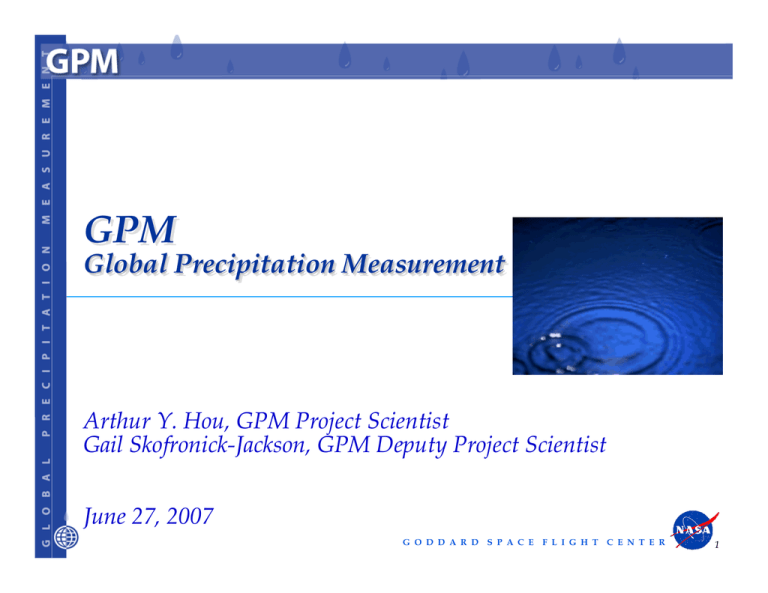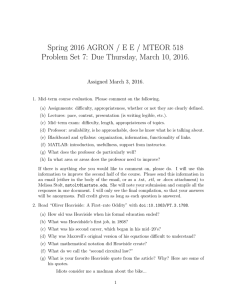GPM - CloudSat
advertisement

GPM Global Global Precipitation Precipitation Measurement Measurement Arthur Y. Hou, GPM Project Scientist Gail Skofronick-Jackson, GPM Deputy Project Scientist June 27, 2007 G O D D A R D S P A C E F L I G H T C E N T E R 1 GPM integrated science objectives Precipitation measurement technology: advancing precipitation measurement capability from space - through combined use of active and wide-band passive remote-sensing techniques to calibrate dedicated & operational PMW sensors to achieve global coverage Water/energy cycle variability: advancing understanding of global water/energy cycle and fresh water availability - through better measurement of the space-time variability of global precipitation Weather prediction: improving NWP skills - through more accurate and frequent measurement of instantaneous rain rates Hydrometeorological prediction: advancing flood-hazard and freshwater-resource prediction capabilities - through improved temporal sampling and spatial coverage Climate prediction: improving climate prediction capability - through better understanding of precipitation microphysics, surface water fluxes, soil moisture storage, and latent heating Polar Snowfall Hydrology Mission Meeting June 26-28, 2007 G O D D A R D S P A C E F L I G H T C E N T E R 2 GPM: A Constellation Satellite Mission Science Objectives: Unify and advance global precipitation measurements for research & applications through • advanced active & passive microwave sensor measurements • a consistent framework for inter-satellite calibration • international collaboration in algorithm development and ground validation NASA Constellation Satellite serving as a constellation coverage optimizer • Non-Sun-Synchronous orbit: ~40o inclination and 635 km altitude • Multi-frequency radiometer (GMI) • Improved near real-time hurricane monitoring & prediction Partner Constellation Satellites: GCOM-W DMSP-F18, F19 Megha-Tropiques NOAA-N’ NPP MetOp-B NPOESS-C1 Polar Snowfall Hydrology Mission Meeting June 26-28, 2007 G O D D A R D GPM Core Satellite (NASA-JAXA) serving as a physics observatory and calibration reference • Non-Sun-Synchronous orbit: 65o inclination and 407 km altitude • Dual-frequency Precipitation Radar (DPR) built by Japanese: Ku-Ka Bands (13.6, 35.5 GHz) • Multi-frequency GPM Microwave Imager (GMI): 10.65, 18.7, 23.8, 36.5, 89.0, 166, 183.3 GHz • GMI provides a reference standard for uniform calibration of brightness temperatures of Constellation sensors • DPR & GMI together provide microphysical measurements and a common cloud database for rain & snow retrievals from Core & Constellation sensors S P A C E F L I G H T C E N T E R 3 Temporal Coverage Constellation Revisit Time: GPM in 2014 vs. Current Capability 4 Conical-Scanning Imagers plus 3 Cross-track Sounders Over Land 6 Conical-Scanning Imagers Plus 4 Cross-track Sounders Over Land (< 3h over 45% of globe) (< 3h over 92% of globe) Lin & Hou (2006) Hour TMI, F13, F14, Aqua + 3 NOAA AMSU-B’s over land Polar Snowfall Hydrology Mission Meeting June 26-28, 2007 GPM Core, NASA-1(40o), F18, F19, GCOM-W, Megha-Tropiques + (MetOp-B, NPP, NOAA-N’, & NPOESS-C1) over land G O D D A R D S P A C E F L I G H T C E N T E R 4 Algorithm Development Infrastructure Precipitation Measurement Mission (PMM) Science Team •The GPM Mission is supported by U.S. and Japan Science Teams •The 70 funded scientists on the NASA PMM science team support GPM in the following areas: ¾ ¾ ¾ ¾ ¾ Inter-satellite calibration method development Precipitation algorithm development (rain, light rain, and snow) Ground validation activities Pursuing innovative techniques in precipitation data applications Data system design & development International Partnership in GPM Ground Validation •GPM participation in Canadian CloudSat-Calipso Validation Program – GPM hardware contributions: AMFR (U.Mass), 2D video disdrometers (CSU), Parsivel disdrometers & Snowflake video imager (GSFC) – Unique datasets for snowfall algorithm development – Potential collaboration on satellite simulator algorithms with EarthCARE • U.S.-Finland collaboration on GPM Ground Validation – Finnish national network of ground-based precipitation measurements in a region with frequent snowfall events and within the GPM Core sampling domain. Collaboration focuses on snowfall algorithm development and hydrological applications. Joint research plans in progress. Polar Snowfall Hydrology Mission Meeting June 26-28, 2007 G O D D A R D S P A C E F L I G H T C E N T E R 5 C3VP Instruments Polar Snowfall Hydrology Mission Meeting June 26-28, 2007 G O D D A R D S P A C E F L I G H T C E N T E R 6

